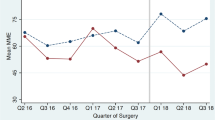Abstract
Background Despite a trend towards minimally invasive thoracic surgeries over thoracotomies, patients can still experience significant post-operative pain. Literature on the use of liposomal bupivacaine in patients undergoing robotic surgeries is lacking. Objective To compare pain control via intercostal nerve block with liposomal bupivacaine to bupivacaine for patients undergoing robotic assisted thoracic surgery. Setting A 455 bed community hospital. Methods This was a prospective observational study with a historical control group of 96 patients who underwent robotic lung resection. Patients in the control group received bupivacaine, while the intervention group received liposomal bupivacaine. Main outcome measure Average pain scores 24, 48, and 72 h after surgery. Results There were no significant differences in average pain scores between groups. The frequency of ketorolac use on the first post-operative day was lower for those who received liposomal bupivacaine. There were no significant differences in opioid requirements, length of stay, or rate of complications. Conclusions There was no significant difference in post-operative pain control between patients receiving liposomal bupivacaine and bupivacaine for robotic assisted surgery.
Similar content being viewed by others
References
Craig DB. Postoperative recovery of pulmonary function. Anesth Analg. 1981;60:46–52.
Apfelbaum JL, Ashburn MA, Connis RT, Gan TJ, Nickinovich DG, Caplan RA. Practice guidelines for acute pain management in the peri-operative setting: an updated report by the American Society of Anesthesiologists Task Force on Acute Pain Management. Anesthesiology. 2012;116:248–73.
Villamizar NR, Darrabie MD, Burfeind WR, Petersen RP, Onaitis MW, Toloza E. Thoracoscopic lobectomy is associated with lower morbidity compared with thoracotomy. J Thorac Cardiovasc Surg. 2009;138(2):419.
Seder CW, Hanna K, Lucia V, Boura J, Kim SW, Welsh RJ. The safe transition from open to thoracoscopic lobectomy: a 5-year experience. Ann Thorac Surg. 2009;88(1):216.
Farjah F, Wood DE, Mulligan MS, Krishnadasan B, Heagerty PJ, Symons RG. Safety and efficacy of video-assisted versus conventional lung resection for lung cancer. J Thorac Cardiovasc Surg. 2009;137(6):1415.
Flores RM, Park BJ, Dycoco J, Aronova A, Hirth Y, Rizk NP. Lobectomy by video-assisted thoracic surgery (VATS) versus thoracotomy for lung cancer. J Thorac Cardiovasc Surg. 2009;138(1):11.
Davies RG, Myles PS, Graham JM. A comparison of the analgesic efficacy and side-effects of paravertebral vs. epidural blockade for thoracotomy—a systematic review and meta-analysis of randomized trials. Br J Anaesth. 2006;96:418–26.
Joshi GP, Bonnet F, Shah R, Wilkinson RC, Camu F, Fischer B. A systematic review of randomized trials evaluating regional techniques for postthoracotomy analgesia. Anesth Analg. 2008;107:1026–40.
Exparel (Package Insert). 2014 San Diego Pacira Pharmaceuticals, Inc.
Rice D, Cata J, Mena G, Rodriguez-Restrepo A, Correa AM, Mehran RJ. Posterior intercostal nerve block with liposomal bupivacaine: an alternative to thoracic epidural analgesia. Ann Thorac Surg. 2015;99(6):1953–60.
Khalil K, Boutrous M, Irani A, Miller CC, Pawelek TR, Estrera AL. Operative intercostal nerve blocks with long-acting bupivacaine liposome for pain control after thoracotomy. Ann Thorac Surg. 2015;100(6):2013–8.
Parascandola SA, Ibanez J, Keir G, Anderson J, Marshall MB, Flynn D. Liposomal bupivacaine versus bupivacaine/epinephrine after video-assisted thoracoscopic wedge resection. Interact CardioVasc Thorac Surg. 2017;24:925–30.
Bellomo R, Ronco C, Kellum JA, Mehta RL, Palevsky P. Acute renal failure—definition, outcome measures, animal models, fluid therapy and information technology needs: the Second International Consensus Conference of the Acute Dialysis Quality Initiative (ADQI) Group. Crit Care. 2004;8(4):R204–12.
Acknowledgements
We thank Jennifer Lineweaver for her effort and expertise with data collection.
Author information
Authors and Affiliations
Corresponding author
Ethics declarations
Funding
No funding was received for this study.
Conflicts of interest
All authors declare that they have no conflicts of interest.
Additional information
Publisher's Note
Springer Nature remains neutral with regard to jurisdictional claims in published maps and institutional affiliations.
Rights and permissions
About this article
Cite this article
Rincavage, M., Hammond, L., Reddy, S. et al. Pain control using liposomal bupivacaine versus bupivacaine for robotic assisted thoracic surgery. Int J Clin Pharm 41, 258–263 (2019). https://doi.org/10.1007/s11096-018-0776-8
Received:
Accepted:
Published:
Issue Date:
DOI: https://doi.org/10.1007/s11096-018-0776-8




